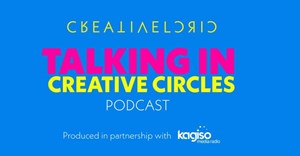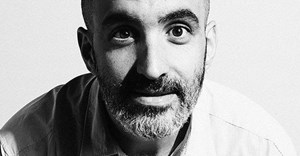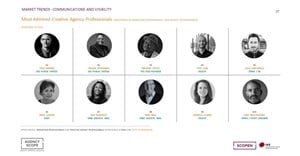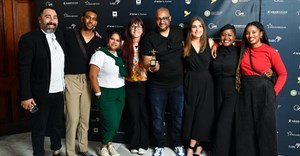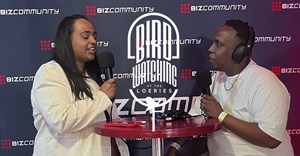Trending
#Loeries2016: 'Great work can be highly contagious'
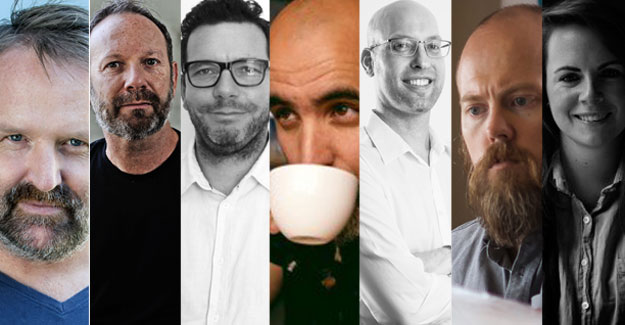
Kirk Gainsford, CCO of MullenLowe; Alistair King, cofounder and CCO of King James; John Davenport, ECD at Ireland/Davenport; Carl Willoughby, ECD of OpenCo; Adrian Varkel, managing director of 140 BBDO Cape Town; Lucas van Vuuren, executive creative director at The Jupiter Drawing Room CT; and Camilla Clerke, creative director at Hellocomputer share their thoughts below…
1. Explain the true significance of a campaign win at the Loeries, for agency and client alike.
Gainsford: For years, there’s been a great divide related to how clients and agencies perceive award-winning work. However, there’s overwhelming evidence now that winning at South Africa’s most prestigious awards show creates significantly more momentum and exposure for the brand, the client and the agency. This holds true particularly for digitally savvy clients and for clients that realise the value of social media. Everyone loves a winner. Winners are celebrated, and brands that are celebrated get noticed.
King: Most of the time, you have a very strong sense of whether you work is good or not long before the awards night. The prize is just industry affirmation, and wonderful affirmation at that. I have, however, seen great work win nothing, and rubbish work clean up. I think you have to put awards into perspective – it’s a flawed process after all, and only one perspective of what you do. You just have to enjoy the moment if the voting swings your way. But winning at the Loerie Awards certainly does lift the creative ambitions of any client and agency. Once you’ve had a good year, you strive to keep the good work up – you press a little harder and dig little deeper for your next idea. Great work can be highly contagious.
Davenport: While awards for awards’ sake isn’t a big deal, a win at the Loeries is a big deal. It’s a big deal for agency AND client. The reality is that great creative ideas sell product, and selling product is what we do. It’s how we make a living. If we aren’t selling product for clients we might as well shut up shop! Thus a win at the Loeries demonstrates to clients that an agency can make every rand they spend on communication go MUCH further. The consumer does not want boring messaging. Boring messaging WASTES marketing budgets. Effective, hard-hitting communication that gets noticed can be marketers’ competitive advantage in a tough and competitive marketplace.
Willoughby: Awards, as a creative and as an agency, are the currency on which we survive. It’s the reassurance that potential clients require when considering their potential agency partner. Clients are proud when winning but, unfortunately, not enough clients share this feeling of pride. And while it’s the measure of our creativity and all the accompanying recognition, many clients feel compromised in our pursuit of these accolades. The true significance is being recognised for outstanding disruptive work, for clients to be honoured and recognised in their part of the process.
Varkel: As BBDO, our aim is to push for big, famous, integrated work. Work that our clients and ourselves can be proud of. Work that delivers on real business needs. When it gets recognised by the industry and our peers, it’s great validation and testament to a healthy client-agency relationship. Getting to great work isn’t easy and when we produce something that’s lucky enough to get awarded at the Loeries, we feel rather triumphant.
Van Vuuren: Of all the categories, this is where you show how legit you are as an agency and you know what you’re doing. Winning a campaign bronze, silver or gold is a sign that the overall thinking behind the idea worked as a coherent, understandable and relevant piece of communication. It’s a sign that all disciplines were working together, every person from the client to the photographer knew what to do to make each element work together. The danger with campaigns is that the idea gets diluted by spreading it too thin across different media. The agencies who can get this bit right understand that you need to adapt to the platform and not repeat the idea over and over. It’s our job as agencies to make our clients look good and connect with their audience everywhere.
Clerke: Winning a Loerie means far more than just receiving a shiny bird to add to a growing collection on an agency wall. It says something about the type of work your agency is doing and the relationship it builds with its clients. Only a great agency-client relationship can solve real business problems, create work that stands out in a very repetitive industry, and really appeal to a target market to get incredible results. Loeries represent far more than award-winning campaigns, but winning relationships too.
2. This year’s Loeries theme is ‘Creativity Unites’. Do you agree with the sentiment?
Gainsford: As far as I’m concerned, creativity separates. It separates winners from losers. The men, wait, the women from the girls. You’re either creative, or you wither and die. Make a statement or fade away. There’s overwhelming evidence in favour of creatively awarded work. Clients ignore this fact at their peril.
King: Strangely enough, I tend to think creativity can be very polarising. Not everyone wants it or appreciates it, or even knows what it looks like when they see it. It’s a very personal thing. But I agree with the spirit of the Loeries campaign. Creativity is remarkable and can change brands and thinking in a very dramatic way. Without flair and imagination, the world would be a very dull place, and that’s worth fighting for.
Davenport: Great creative unites people. It brings people together. It does this through creating an emotional response. Given that we’re all emotion beings, creative work should always strive to unite and bring people together.
Willoughby: Yes and no. Most creatives appreciate great creative work. As individuals we all share the same passion but don’t always agree on all the awarded work, that the grands prix across various categories deserved winning etc. It’s a very subjective business. I guess we’re united in our pursuit of creativity but our exact perception of what is or isn’t creative varies.
Varkel: Of course. There are plenty of examples. People are naturally drawn to creativity. It’s quite bizarre that some still don’t see the link between creativity and effective advertising. We watch TV series. Listen to music. Buy sneakers. They’re all forms of creativity that we unite through. That’s the reality of what brands are up against for a share of mind. So when you need to sell a toothbrush, you’re competing with Game of Thrones. The best advertising has to compete in this unified creative space.
Van Vuuren: I think, probably a bit arrogantly, that the only thing that can unite people is creativity, I don't think an Excel sheet will ever be able to bridge the divide between race, creed or religion, unless we unite people with the shared hatred of diagrams and percentages. I love the Drought Packaging idea for Clover, this is a great example of ‘simple and powerful’. Please be real. Please be real. Please be real. Please be real.
Clerke: Creativity does unite: In the advertising industry, where different people with different ways of thinking all get behind an idea they believe in and work tirelessly to make it happen. And, on a much larger scale, where that creative idea can change the way an entire nation thinks, too. FCB Inferno’s Project Literacy and This Girl Can have done that well.
3. What’s the impact of an individual Loeries accolade or ranking on that creative’s career?
Gainsford: At MullenLowe, we don’t only hire winners. We hire hungry creative people with the drive and the will to win. They will be winners. This is what great clients want. An agency full of competitive, energetic, driven winners that will do what it takes to win awards, market share, and share of voice.
King: I’ve been pleasantly surprised by the personal attention I’ve received from last year’s ranking. I can’t say it’s dramatically changed my life, but it most certainly has boosted the ego a little and added to the list of career highlights. In most cases I’m sure a great ranking does translate into other career perks, but in my case, working in my own agency, it’s not like I’m going to give myself a salary increase or a spot bonus. I see my ranking as a result of the great work done by my teams and so the credit must ultimately go to them. And I suspect that’s true for everyone who gets a good ranking.
Davenport: It means that one is doing a good job for one’s clients. Be they big or small, all clients deserve effective communications. Accolades like the Loeries demonstrate that to clients. And that’s good for agencies and individual advertising people in a personal capacity.
Willoughby: Creativity adds value. To a brand and certainly to the ECD or CCO. It gives them credibility and recognition among their peers and clients within the marketing fraternity.
Varkel: The impact of a Loeries accolade can make a career. However, we hope both the creatives and the industry will look beyond a one-hit-wonder. What we really want is consistency and fresh thinking over time and across a range of brands that use creativity to solve business problems. That being said, for an agency team it’s an amazing accolade and confidence booster. For an agency, it’s a way to measure relevance and attract talent and retain talent. For a client, it’s a reward for making brave choices, however small.
Van Vuuren: I think it’s a natural thing to rank people. I reckon it shows that the person is very good at winning awards, we must be careful to not make that the defining thing that we measure ad people by.
Clerke: It shows that he/she can be part of a team that produces work that matters – which means more respect, more recognition and an extra craft beer at the agency bar.
4. Let us in on your current favourite work from the rest of the industry and why it resonates with you.
Gainsford: Predictions are simple: At the end, no-one goes back to check whether it was right or wrong. In the end, it’s the jury that’ll decide. However, I will say that SA had an incredible year at Cannes, and the Grand Prix in radio from Ogilvy cannot be ignored. Added to this, the poster campaign from an agency regarded as a ‘digital agency’ also cannot be ignored. The world changes every day.
King: As a rule, I’m favouring brand advertising this year. If it’s strong work in a difficult category with a demanding client with real marketing challenges, you’ll get my vote. We’re a serious industry and I plan to reward work that acts like it.
Davenport: I love the KFC “Everyman” radio work. It shows that a great, well-crafted idea can use entertainment to sell a product. It’s clearly a hard-working piece of retail work. Far too often, retail doesn’t get the love and attention it deserves. Retail should demonstrate our best work and never be something that agencies just bash out…
Willoughby: Globally, coming off the back of Cannes I love the Libresse Tampons commercial. I know, never thought I’d say that but it’s different/fresh/honest within that category. The Geico 15% off car insurance campaign as well as its pre-roll campaign. Locally I think Native’s campaign for Passop will do well. It capitalised on something topical. Beautifully shot, simple. I also loved Geometry Global Cape Town’s Iziko Slave Museum calendar, based off an insight I never knew but I love, possibly because I’m from Cape Town. But well-crafted design, beautiful case study. I also love the craft that went into KFC Man Meals radio as well for Student Flights and Peaceful Sleep. There’s also the Cell C phone insurance, which I love from a local point of view.
Varkel: Obviously we have to be a bit biased here and give our work a good punt (hey, it’s advertising) – Coronation, Chicken Licken and Pam Golding. And to be fair, we think Sanlam/Santam are doing inspiring, innovative real work right now.
Van Vuuren: CANSA Testimonials – Because talking balls are awesome. Clover Draught Packaging – Because I mentioned it before. KFC Man Meals radio – Because it’s funny AF. Twitter Refugees – Because it’s so simple.
Clerke: There are a couple of pieces that stand out. Native VML and Passop’s #IAmMuslim campaign used simple and profound creative to intercept an incredibly emotional time in the lives of many, proving that creativity can change the way people think. The VW Social Test Drive solves an interesting business problem – the fact that the target market doesn’t get to test drive the Amarok where it really performs well, on the road less travelled. The addition of delivering supplies to people who need them in remote areas of South Africa made the content even more appealing.
Here’s to an insightful, inspirational creative week all round. Follow the #Loeries2016 hashtag on Twitter for more and click here for a reminder of what the attendees are most looking forward to from Loeries® Creative Week™ Durban…









